| Oct 20, 2011 |
Research grant to learn the secrets of diatoms' nanoscale silica production
|
|
(Nanowerk News) A scientist at the University of Bristol has been awarded £1.3 million to unlock the secrets of miniscule algae cells that have the remarkable ability to produce silica – the fundamental constituent of glass. It is hoped the findings from the research could lead to the next generation of medical imaging tools.
|
|
Inspired by the diatoms, a type of algae dubbed 'Nature's nanotechnologists', Dr Paul Curnow from the University's School of Biochemistry has been awarded the prestigious European Research Council (ERC)-funded grant to understand how diatom cells manipulate silica to coat themselves in an intricate outer sheath of clear glass.
|
 |
| The image shows part of a group of diatoms viewed with a light microscope using Jamin-Lebedeff Polarising Interference. 160:1 on 35 mm slide.
(Image: Spike Walker, Wellcome Images)
|
|
Dr Curnow is already working with colleagues at Bristol to study a unique set of diatom proteins that recognise and transport soluble silica. The ERC grant, one of only 30 such grants awarded to UK bioscientists in 2011, will enable him to use these proteins to create a synthetic diatom that can behave as a novel 'nanoreactor' for the controlled synthesis of functional silicon nanomaterials.
|
|
Dr Curnow, Research Fellow, said: "Diatoms have found a way of controlling silica at the nanoscale that is very sophisticated and is far beyond what we can achieve in the lab. Learning the secrets of these remarkable cells should enable us to make new catalysts, sensors, diagnostic devices and medical imaging tools."
|

